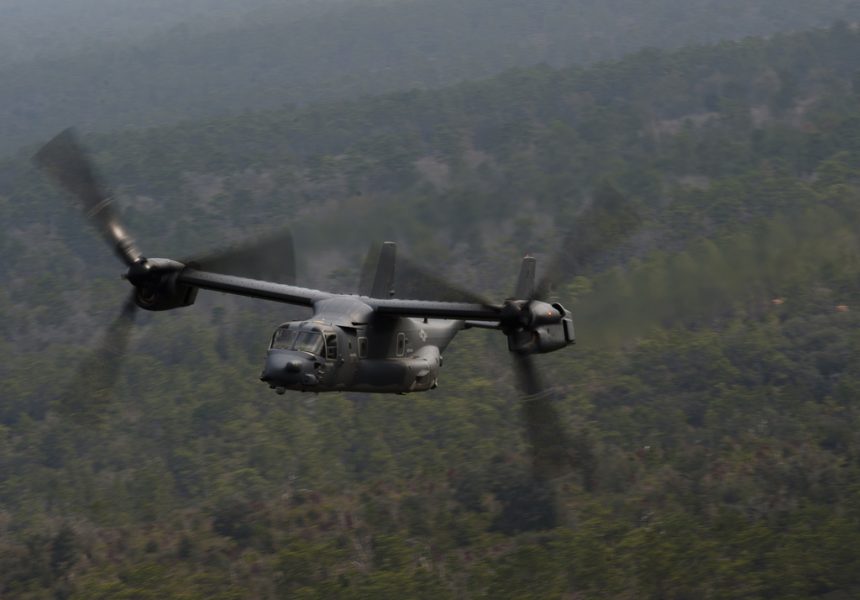Recently, U.S. Department of Defense officials have had to organise a director level meeting with the Japanese Ministry of Defence and department of Foreign Affairs, to provide an update with regards to the MV-22 and CV-22 Osprey aircraft issues.
Pentagon press secretary George Little spoke to reporters and described the meeting as “An effort to address concerns about the aircraft by the governor of Okinawa” as the Department of Defence plans to base the MV-22, the Marine Corp version of the aircraft, to the Asia Pacific region.
Little also said “The Department of Defence takes the inquiries made by the Japanese government seriously and provided relevant information to the extent currently possible.”
“The Osprey is a highly-capable aircraft with an excellent operational safety record, which includes more than five years of worldwide deployments and 140,000 flight hours” Little said.
This came in light of another incident that involved a CV-22 Osprey that crashed on Eglin range in Florida on Jun. 13 2012 that has fueled once again concerns about the safety of the tilt rotor that, in spite of the Air Force and Marine Corps claims, has been much debated in the recent past.
However, the last episode could have had in the human factor its “root cause”. Indeed, AOL Defense’s Richard Whittle reported that the pilot in command of the Osprey that has recently crashed in Florida, was also the co-pilot of an AFSOC tilt rotor aircraft that crashed in Afghanistan on Apr. 8, 2010.
It’s not been disclosed whether the pilot Maj. Brian Luce or co-pilot Capt. Brett Cassidy were at the controls of the Osprey when it went down last June during a training exercise. All onboard suffered undisclosed injuries but were released from hospital a couple of days later.
The CV-22 was flying in helicopter mode along with another Osprey. Among the possible causes of the crash there is the possibility that it went into the rotor wash of the other tilt rotor aircraft: a powerful turbulence that can cause an unrecoverable “roll off”. Osprey crew members are warned to keep a safe distance to prevent this dangerous situation.
“The results of the Accident Investigation Board will guide our decisions, if there’s some misbehaviour on the part of the crew or if they performed in a way that was unsatisfactory, it’s too early to say whether they will or won’t face any disciplinary action” said 1st Special Operations Wing’s commander Col. James Slife in an interview with AOL Defense.
With an investigation still in progress, it’s too early to determine what will happen to Luce and Cassidy with regards to a disciplinary hearing or whether they will face penalties for the crash. However, in the meanwhile, Slice has relieved Lt. Col. Matthew Glover of command at the 8th Special Operations Squadrons since “philosophically” all the military services hold commanders responsible for what happens in the units, he said to AOL Defense.
The accident that Luce had been in previously in Afghanistan took place during a night raid against insurgents, where the Osprey had a “Hard Landing” and had caught its nose in a ditch when the nose wheel collapsed and flipped the Osprey onto its back killing 4 of the 19 occupants.
The crash investigators in that occasion found several contributing factors to the crash but none that could be singled out as the “root cause”. Among them: all from the crew being distracted as they pressed to make their landing zone, a 17 kts tailwind and a possible loss of engine power (although this was overruled by the commander of AFSOC, citing engineering studies that detected no evidence of power loss).
Noteworthy, about two months ago, a U.S. Marine Corps tilt rotor aircraft crashed in Morocco during African Lion joint exercise with two marines killed and two other severely injured in the crash.
Richard Clements for TheAviationist.com
Related Articles
- U.S. Air Force CV-22 Osprey tilt rotor aircraft crashes on Eglin range (theaviationist.com)
- Two Marines killed and two severely injured in MV-22 Osprey tilt rotor aircraft crash in Morocco (theaviationist.com)









